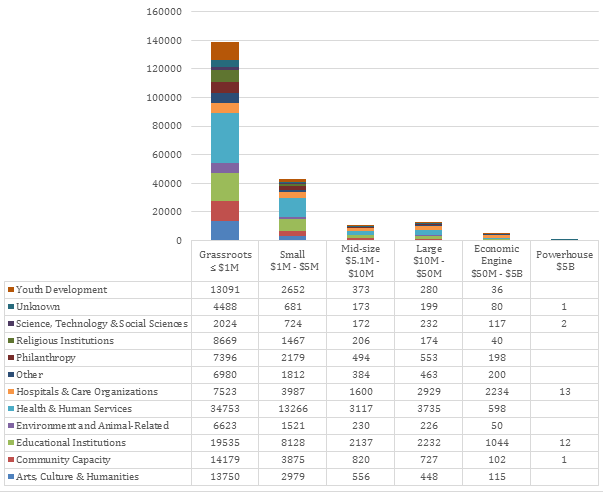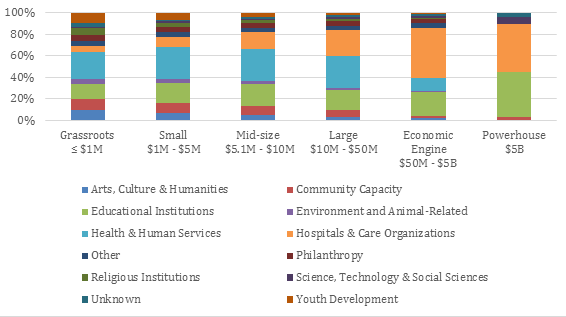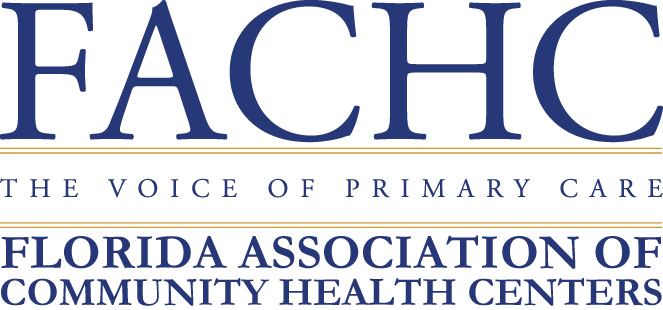When we think about nonprofits, the most well-known brands, such as the Salvation Army, Goodwill, or the American Heart Association, might immediately come to mind. But these charities are only a sliver of the organizations that can be found within the nonprofit sector and, in most cases, are even outliers.
That's why we are using our extensive database to paint a better picture of the nonprofit landscape. Here are three of our initial findings:
1. THE VAST MAJORITY OF NONPROFITS ARE SMALL, GRASSROOTS ORGANIZATIONS

The majority of nonprofits (66.3%) have annual budgets of less than $1 million. From there, as organization size increases, the number of nonprofits decreases. For every 1 powerhouse (annual expenses more than $5 billion) nonprofit, there are thousands of grassroots organizations.
In this respect, the nonprofit sector may mimic your community—lots of small businesses mixed in with far fewer large businesses. Looking at Fortune 500’s list confirms this. Walmart, the largest company, is more than twice the size of the 3rd-largest company, Apple. In turn Apple is twice the size of the 15th-largest company, Costco. The bigger the size, the fewer the companies.
2. NONPROFIT SIZE VARIES BY CAUSE AREA
Overall Sector Composition—% NTEE Per Economic Size

Health and human service organizations make up the largest proportion of nonprofits with annual expenses between $0 and $50 million. This category covers cause areas such as mental health, diseases and disorders, food and nutrition, housing and shelter, and services provided for humans (low-income families, youth, immigrants, and more). Once expenses exceed $50 million, however, hospitals and care organizations dominate. They include hospitals, clinics, nursing programs, and patient services. At the highest level (more than $5 billion), education nonprofits (universities, mostly) join hospitals and care organizations as the most prevalent. This makes sense when you consider the vast numbers of employee and facilities costs for these types of institutions.
Our next post will look more closely at educational institutions and hospitals and care organizations, which deserve a more focused “deep dive.”
3. ARTS, ANIMAL, ENVIRONMENT, AND YOUTH DEVELOPMENT ORGANIZATIONS TEND TO BE SMALLER THAN OTHER TYPES OF NONPROFITS
Arts, culture, and humanities, environment and animal-related, and youth development nonprofits generally fall below the $10 million threshold. Examples of these organization types include art museums, national park conservatories, animal shelters, recreational and athletics programs, and boys and girls clubs.
It’s quite possible that bigger isn’t better for these cause areas. For example, a single canine shelter might be able to care for 50 dogs more cost-effectively than it can care for 10 dogs. But does the unit cost continue to decrease if there are 1,000 dogs? Can the quality of care remain the same?
It may be helpful to consider that the value and impact of some types of services might not scale naturally.
Keep in mind that these expense figures may be artificially low. Arts, environment/animal, and youth development organizations likely rely more heavily on volunteers than nonprofits in other cause areas. Unlike donations of dollars or goods, donated person hours are not recorded under expenses or revenue in an organization’s 990. As a result, much of what would usually be labor costs disappear from the total expenses. This fact contributes to the narrative that some organizations can accomplish the impossible on a shoestring budget.
That's all we have for you this week! Check back soon for our exploration of hospitals and universities—“Meds ’n’ Eds.”
Source: GuideStar.Org
Kerstin Frailey









